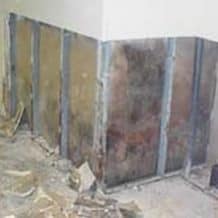How to Find Indoor Mold

Indoor Molds can be found just about anywhere, but most often they are found indoors on or around plumbing fixtures like sinks, tubs, toilets, showers, air-conditioning systems and water-heaters. It is also quite commonly found near points such as roof leaks, improperly sealed windows, foundation slab cracks, unsealed concrete foundations, cracks in siding and plumbing leaks. It can also be found, as in the picture at the left, behind wallboard or flooring, especially in humid climates or when insulation is lacking.
Image: A lot of mold was hidden behind these sheetrock panels, invisibly but negatively affecting the health of everyone living there.
Checking for Hidden Mold
Carpeting that has been water damage or is exposed to high levels of humidity is prone to mold growth. You can detect mold by lifting a small section of the carpeting away from the floor and looking for.
Get down to floor level – look under bathroom and kitchen cabinets in spaces that are not easily seen.
Open up wall cavities in the kitchen and bathroom to check for mold growth.
Air conditioners and furnaces need to be thoroughly inspected for stagnant water and serviced regularly. Furnace duct systems should also be thoroughly cleaned regularly.
Mold colors may be white, gray, black, brown, yellow or greenish, or a combination of these. Colonies of mold may appear cottony, velvety, granular, leathery and glassy.
WHERE TO LOOK FOR MOLD
Around and under plumbing fixtures:
sinks
tubs
toilets
showers
air-conditioners
heating systems
water-heaters
Places leaks from outside are likely:
uninsulated outside walls
improperly sealed windows
cracks in siding
roof eaves
concrete slab cracks
unsealed building foundations
Q. If you do have mold, do you need to call a professional?
A. Not necessarily, it depends on the type(s) of mold and how much has grown. If you have less than 10 square feet of molds that are strictly a Type I Allergen these may be usually be cleaned up and kept at bay using a soapy or 25% bleach and water solution. If, however, the mold is Toxic, the services of a professional remediation company should be acquired.
Next : How Mold Gets There






